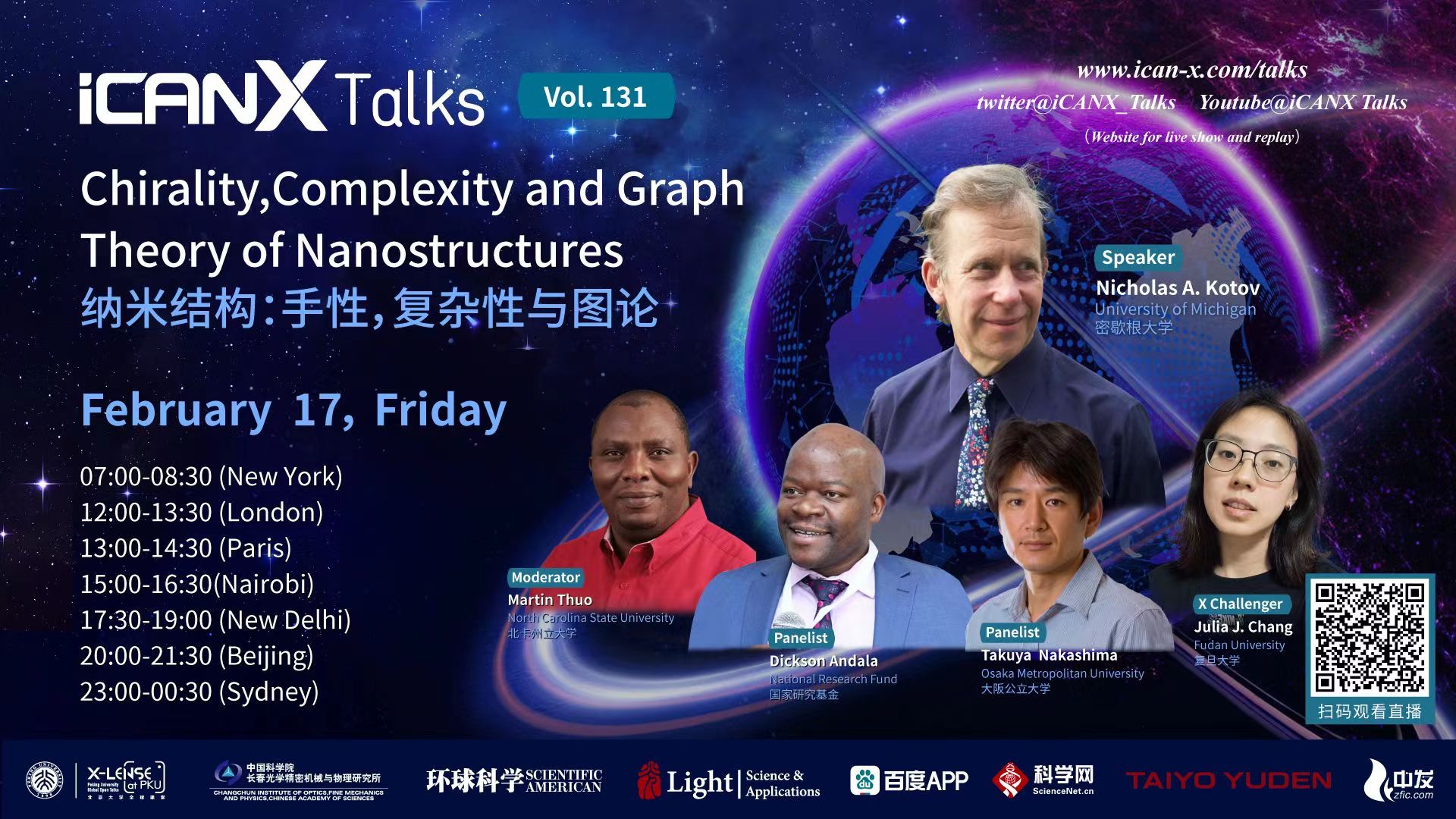博文
iCANX Talks第131期丨密歇根大学Kotov教授:《纳米结构:手性,复杂性与图论》
||
2022年2月17日晚八点,iCANX Talks 第131期将在iCANX平台上线!本期我们邀请到美国艺术与科学院,美国国家发明家科学院院士、密歇根大学教授Nicholas A. Kotov带来题为《纳米结构:手性,复杂性与图论》的精彩讲座!更多精彩,敬请期待!

Chirality, Complexity and Graph Theory of Nanostructures
ABSTRACT
从达芬奇开始,科学研究就致力于通过非生物方法将大自然中历经进化筛选后的特殊分子,组织或生物体形貌制备出来。其中,由金属,半导体或陶瓷材料构筑的手性纳米结构(chiral nanostructures)就是拥有特殊几何构型的材料中发展迅速的一大类。除去这类材料迷人的光学,催化及生物性质之外,我们对其手性纳米结构的深入研究也带来了新的发现。不同于其它几何特性,镜像非对称性(即手性)与材料的尺度无关。因此,研究手性纳米基元的合成及组装过程可以让我们更加了解大自然是如何从几何构型简单的组装单元“大杂烩”中构造出功能复杂且自适应的宏观材料的。通过分析由手性纳米颗粒层级组装而成的宏观材料,我们探究了该体系中功能复杂性的形成机理及其受颗粒结构多样性的影响程度。 Since Leonardo Da Vinci discoveries in science and engineering were inspired by evolution-optimized geometry of molecules, tissues, and organisms found in biology using non-biological preparatory techniques. Chiral nanostructures – a large and rapidly evolving class of metal, semiconductor, and ceramic materials is one of these materials. Besides fascinating optical, catalytic, and biological properties, the studies of chiral nanostructures revealed something more. Unlike other geometric properties, mirror asymmetry is invariant to scales. Thus, the synthesis and self-assembly of chiral nanostructures showed how basic geometric properties of the ‘messy soup’ of Nature’s smallest building blocks can produce highly complex functional and adaptable structures at macroscale. Analysis of the hierarchically organized micro- and macrostructures obtained by self-assembly of the chiral nanoparticles (NPs) demonstrated the mechanism of emergence of functional complexity in such systems and how such diversity of the building blocks contributes to it. 以上发现是通过图论(graph theory,GT)实现的,具体来说,我们将手性纳米颗粒描述为节点,将纳米颗粒间的界面描述为边,然后应用图论对组装体的结构复杂程度进行计算与定量研究。举例来说,图1展示的是一种类刺猬形扭曲尖峰结构,该结构由多分散的金-半胱氨酸纳米片基元层级组装而成,通过研究该结构我们发现:(a)层级组装产物的结构复杂度不依赖于组装基元的单分散性;(b)从合成基元出发制得的结构复杂指数(complex index, CI)高于其对应的生物原型结构;(c)组装结构的复杂度来源于相互竞争的手性组装限制条件。除了用于对“手性刺猬”形貌的描述,图论也可被用于研究可组装为分子构型的纳米颗粒体系。 These findings became possible by applying graph theory (GT) for calculation of the quantitative measures of their complexity by describing the constituent NPs as nodes and the interfaces between them as edges of graphs. Taking an example of hierarchically organized particles with twisted spikes from polydisperse Au-Cystein nanoplatelets in Fig. 1, we found that (a) formation of complex structures does not require monodispersity; (b) complexity index (CI) of the synthetic particles can be higher than biological prototypes; and (c) complexity emerges from competing chirality-dependent assembly restrictions. The GT description of chiral hedgehogs can also be expanded to other nanoscale structures creating analogs of chemical formulas for particle systems.
除去探索结构手性与复杂度的关系,图论对纳米结构的分析也促成了对仿生材料结构有序无序度的定量描述,而有序度对于材料的功能性来说至关重要。将图论的研究对象从粒子延伸到化合物标志着这种方法从基于试错的工程尝试向多属性功能材料设计的转变。通过利用图论对芳纶网络结构进行多参数优化,我们得到了可用于机器人电池或生物医疗植入体的材料。(图2)虽然仍处于研究初级阶段,我们相信这种基于图论对仿生材料进行工程设计的方法前景光明。 Among other outcomes of the analysis of the chirality-complexity relations, GT-based description of nanostructures leads to quantitative description of biomimetic materials combining order and disorder that is essential to their functionality. Expansion of GT principles from particles to composites enabled transition from inexact approach of their good-luck-based engineering to function-driven design encompassing multiple properties. While this work is still in progress, the methods of GT-based biomimetic materials engineering can be demonstrated by the multiparameter optimization of complex networks of aramid nanofibers for batteries for robotics and biomedical implants (Fig. 2).
BIOGRAPHY 尼古拉斯∙科托夫是密歇根大学的欧文·朗缪尔杰出化学工程教授,他也拥有Joseph B. and Florence V. Cejka 工程教授头衔。他致力于研究复杂纳米结构与自组装纳米材料,领导着一只推进仿生纳米结构实际应用与基础理论研究的国际科研团队。手性纳米结构是他现阶段研究工作的重点,标志着其研究兴趣向物理,化学,生物和医药领域的开拓。尼古拉斯曾获60余次奖项与表彰。与学生一起,尼古拉斯开创众多许多初创公司,专注于仿生纳米结构材料向能源,医疗与汽车领域的商品化转化。尼古拉斯是美国艺术与科学院,美国国家发明家科学院院士。他也是一位著名的残障科学家拥护者。
Nicholas A. Kotov is Irving Langmuir Distinguished University Professor in Chemical Sciences and Engineering and Joseph B. and Florence V. Cejka Professor of Engineering at the University of Michigan. He is pioneer of complex nanostructures and self-assembled nanomaterials leading an international team of scientists advancing practical implementations and theoretical foundations of biomimetic nanostructures. Chiral nanostructures represent a focal point in his current work with translation to physics, chemistry, biology, and medicine. Nicholas is a recipient of more than 60 awards and recognitions. Together with his students, Nicholas is a founder of several startups that commercialized biomimetic nanostructures for energy, healthcare and automotive industry. Nicholas is a Fellow of America Academy of Arts and Sciences and National Academy of Inventors. He is also a known advocate of scientists with disabilities.
https://blog.sciencenet.cn/blog-299-1376672.html
上一篇:张海霞︱妈,对不起!
下一篇:AI美图来啦!
全部作者的精选博文
全部作者的其他最新博文
- • 致敬闪闪发光的青春
- • 幸福
- • iCANX ON the WAY!
- • 尽情绽放、我自芬芳
- • iCANX第一次在非洲设立奖项
- • 马不停蹄地助学,争分夺秒地快乐!